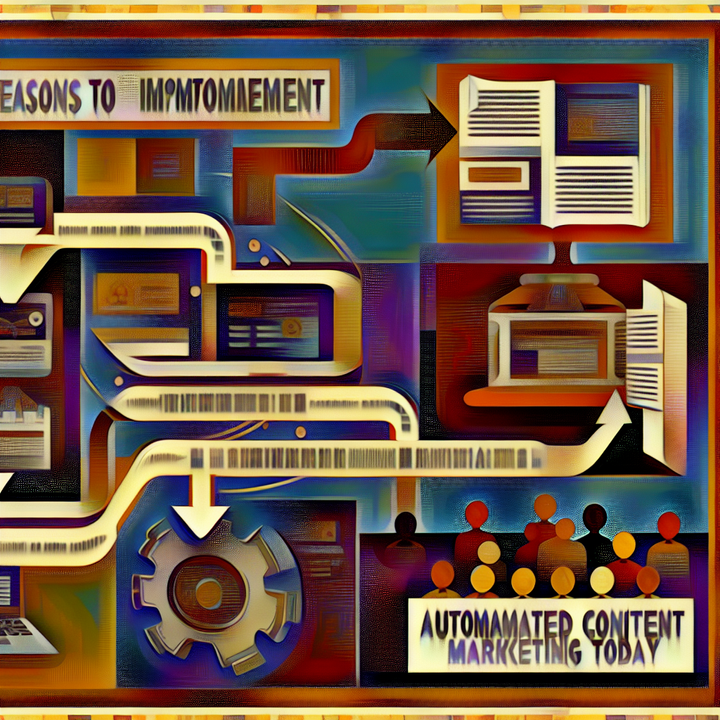Automated Content Generation: What You Need to Know

Understanding Automated Content Generation
Automated content generation is revolutionizing the way businesses approach content marketing. At its core, this technology leverages advanced tools like natural language processing (NLP) and machine learning to create a seamless and efficient content creation process. But what exactly does this mean for a company looking to enhance their digital presence? Let's delve into the mechanics and relevance of automated content generation in today's digital marketing landscape.
Automated content generation uses artificial intelligence (AI) to analyze data inputs and generate relevant content based on pre-defined algorithms. NLP allows the system to understand and mimic human language, while machine learning improves the process over time through continuous learning and adaptation.
In an era where digital content is king, being able to produce high-quality blog posts, articles, newsletters, and social media content swiftly is invaluable. Automated content generation ensures that companies can consistently deliver engaging and SEO-optimized material without succumbing to the time-consuming nature of traditional content creation.
The Benefits of Automated Content Generation
The advantages of automated content generation extend far beyond mere convenience. Here are some of the key benefits:
- Time Savings: Automating the content creation process frees up significant time, allowing businesses to focus on strategic activities rather than getting bogged down in writing tasks.
- Cost-Effectiveness: Reducing the need for a large in-house content team or outsourcing content creation can lead to substantial savings.
- Consistent Output: Automated tools ensure that your content is consistently high-quality and on-brand.
- Ease of Scalability: As your business grows, so too can your content output, without the proportional increase in resources.
- Improved SEO: With built-in SEO optimizations, your content is more likely to rank higher in search engine results, thus increasing your online visibility.
Each of these benefits aligns perfectly with the needs of various target personas. For instance, a Busy Business Owner can save time, a Marketing Manager can ensure consistent output, a Content Strategist can achieve better SEO results, and a Startup Founder can manage content creation without stretching their limited resources.
How Automated Content Generation Works
Understanding how automated content generation works can demystify the process and make it easier to integrate into your marketing strategy. Key components include:
- Data Inputs: These are the raw materials that the AI uses to create content. This can include keywords, existing articles, market trends, and customer data.
- AI Algorithms: These sophisticated mathematical models analyze the data inputs and identify patterns, enabling the AI to generate coherent and relevant content.
- Content Templates: Predefined structures that guide the AI in organizing the content, ensuring it meets specific formats or styles.
- Output Types: The final content can be in various formats such as blog posts, newsletters, social media posts, etc., based on the requirements.
To put it simply, automated content generation tools take your data, apply AI algorithms, and churn out structured content tailor-made for your needs. This process not only simplifies content creation but also ensures that the output is harmonized with your brand's voice and objectives.
Best Practices for Utilizing Automated Content Generation
While automated content generation tools offer immense potential, employing best practices can significantly amplify their effectiveness. Here are some tips:
| Step | Description |
|---|---|
| Initial Setup | Configure the tool with your brand guidelines, target audience, and key objectives to ensure the content aligns perfectly from the start. |
| Content Planning | Develop a content calendar and use the tool to schedule posts, ensuring a steady stream of material without overwhelming your audience. |
| SEO Strategy | Leverage the tool's SEO features to target specific keywords and improve your content’s search engine ranking. |
| Customization | Take advantage of customization options to tweak the generated content to better fit your brand's tone and style. |
| Periodic Review | Regularly review the generated content to ensure it continues to meet your quality standards and make adjustments as necessary. |
By adhering to these best practices, you can maximize the utility of automated content generation tools, ensuring that your content not only maintains high quality but also evolves in tandem with your business objectives.
Automated Content Generation for Different Business Goals
The flexibility of automated content generation makes it a versatile tool for various business objectives, from increasing web traffic to enhancing customer engagement. Here are some specific use cases:
- Increasing Web Traffic: Utilizing SEO-optimized content to rank higher in search results, thereby attracting more visitors to your website.
- Engaging Newsletters: Creating personalized newsletters that cater to your audience’s interests, ensuring higher open and click-through rates.
- Improving SEO: Consistently publishing keyword-rich content that helps in boosting your site’s SEO performance.
- Personalized Customer Communication: Generating customized content for different segments of your audience to foster deeper engagement.
Consider a hypothetical case study of a company named "EcoTech." By integrating Taleflow for their automated content generation, EcoTech managed to increase their web traffic by 35% within six months, thanks to the SEO-optimized articles and engaging newsletters they consistently produced.
Challenges and Limitations of Automated Content Generation
Despite its numerous advantages, automated content generation is not without its challenges. Some of the common pitfalls include:
- Lack of Originality: AI-generated content can sometimes lack the creative flair that human writing offers.
- Occasional Errors: Although AI is highly advanced, it isn't perfect and may produce errors that require human intervention.
- Need for Human Oversight: Content still requires periodic review to ensure it aligns with your brand and messaging.
To mitigate these issues, it's crucial to combine automated tools with human expertise. Regularly reviewing and fine-tuning the content can help overcome these limitations, ensuring that the automated output meets the highest standards of quality and originality.
Measuring Success: Key Metrics to Track
Evaluating the effectiveness of your automated content generation strategy involves tracking several key metrics:
- Traffic Analytics: Monitor your website’s traffic to see how automated content impacts visitor numbers.
- Engagement Rates: Analyze metrics like time on page, bounce rate, and social shares to gauge how engaging your content is.
- Conversion Rates: Track the number of leads or sales generated from your content to measure its ROI.
- SEO Performance: Assess your content’s ranking on search engines to evaluate its SEO effectiveness.
Taleflow offers robust performance tracking features that facilitate the assessment of these metrics, providing you with comprehensive insights into your content strategy’s success. This allows businesses to continually refine their approach for optimal results.
Case Studies: Success Stories with Taleflow
Real-world examples speak volumes about the efficacy of a tool. Let's look at how Taleflow has helped businesses achieve their content marketing goals:
EcoTech: As mentioned earlier, EcoTech saw a 35% increase in web traffic within six months of using Taleflow. Their SEO rankings also improved, leading to a 20% rise in organic search traffic.
WellnessWorks: This wellness startup leveraged Taleflow to create engaging newsletters, resulting in a 45% increase in email open rates and a 30% boost in click-through rates.
RetailRad: RetailRad, an e-commerce platform, experienced a 25% increase in conversions by using Taleflow's automated blog service to produce personalized content, enhancing customer engagement and driving sales.
Each of these case studies underscores the transformative impact of Taleflow’s automated content generation on different business objectives.
Getting Started with Taleflow
Ready to harness the power of automated content generation for your business? Here’s a step-by-step guide to get you started with Taleflow:
- Create an Account: Sign up on the Taleflow website by providing basic information about your business.
- Initial Setup: Configure your account with brand guidelines, target audience, and primary objectives to personalize your content.
- Explore Features: Familiarize yourself with key features like content templates, SEO tools, and scheduling options.
- Customization: Use Taleflow’s customization options to tweak generated content to match your brand’s tone and style.
- Start Creating: Begin generating content by inputting relevant data and keywords. Review and fine-tune the output as needed.
- Monitor Performance: Use Taleflow’s analytics tools to track the performance of your content and make informed adjustments.
With Taleflow, you can simplify your content marketing efforts, ensuring that your business consistently produces high-quality, SEO-optimized content that resonates with your audience and drives results. Whether you're a busy business owner, a marketing manager, or a startup founder, Taleflow offers the tools and features needed to streamline your content creation and distribution process. Sign up today to start your free trial and discover the difference automated content generation can make for your business!



